Personal Injury Lawyer Resume Examples

Jul 18, 2024
|
12 min read
Master personal injury lawyer resume tips with ease: from showcasing your legal expertise to highlighting your courtroom victories, ensure your resume delivers a knockout punch!
Rated by 348 people
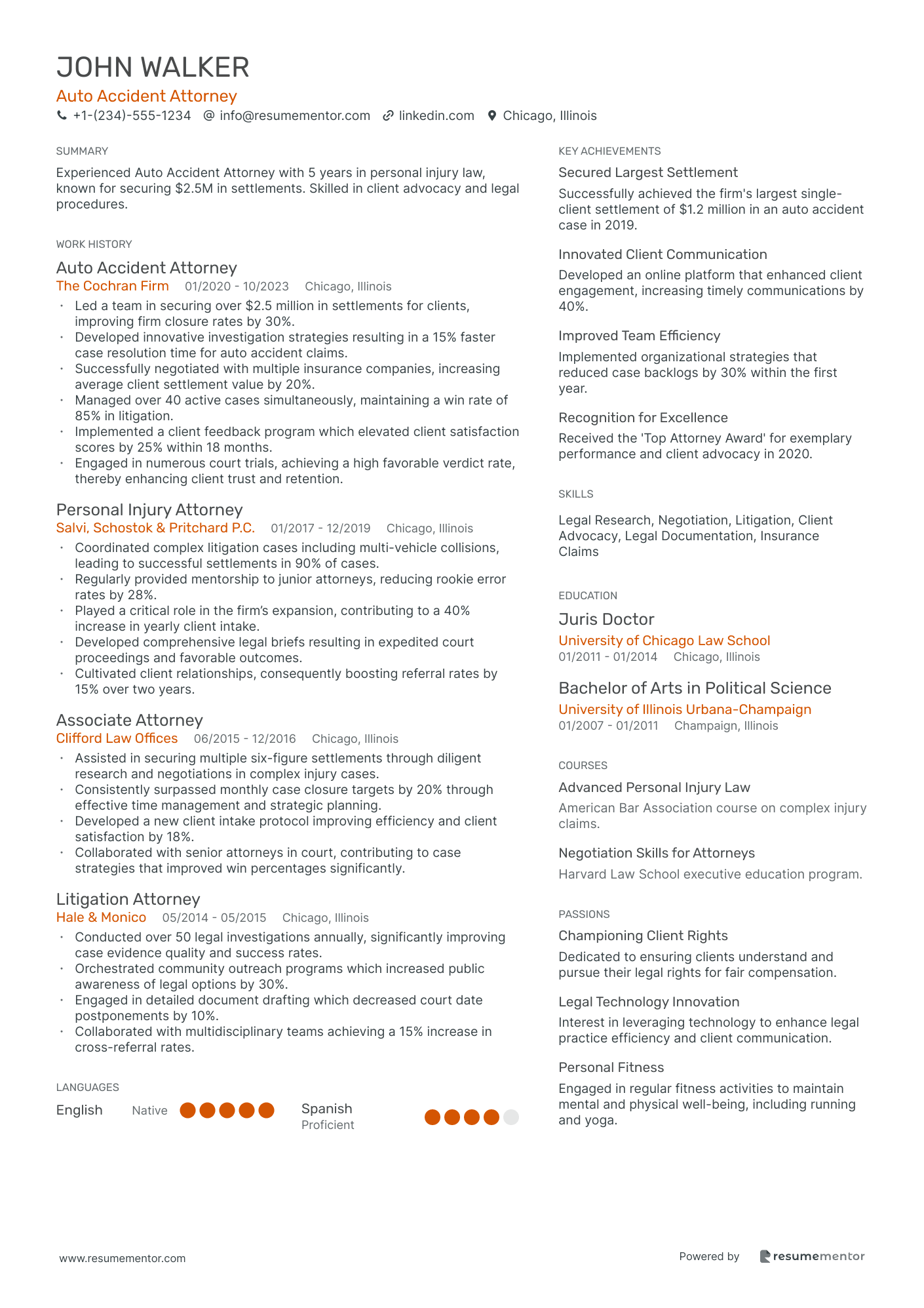
Auto Accident Attorney
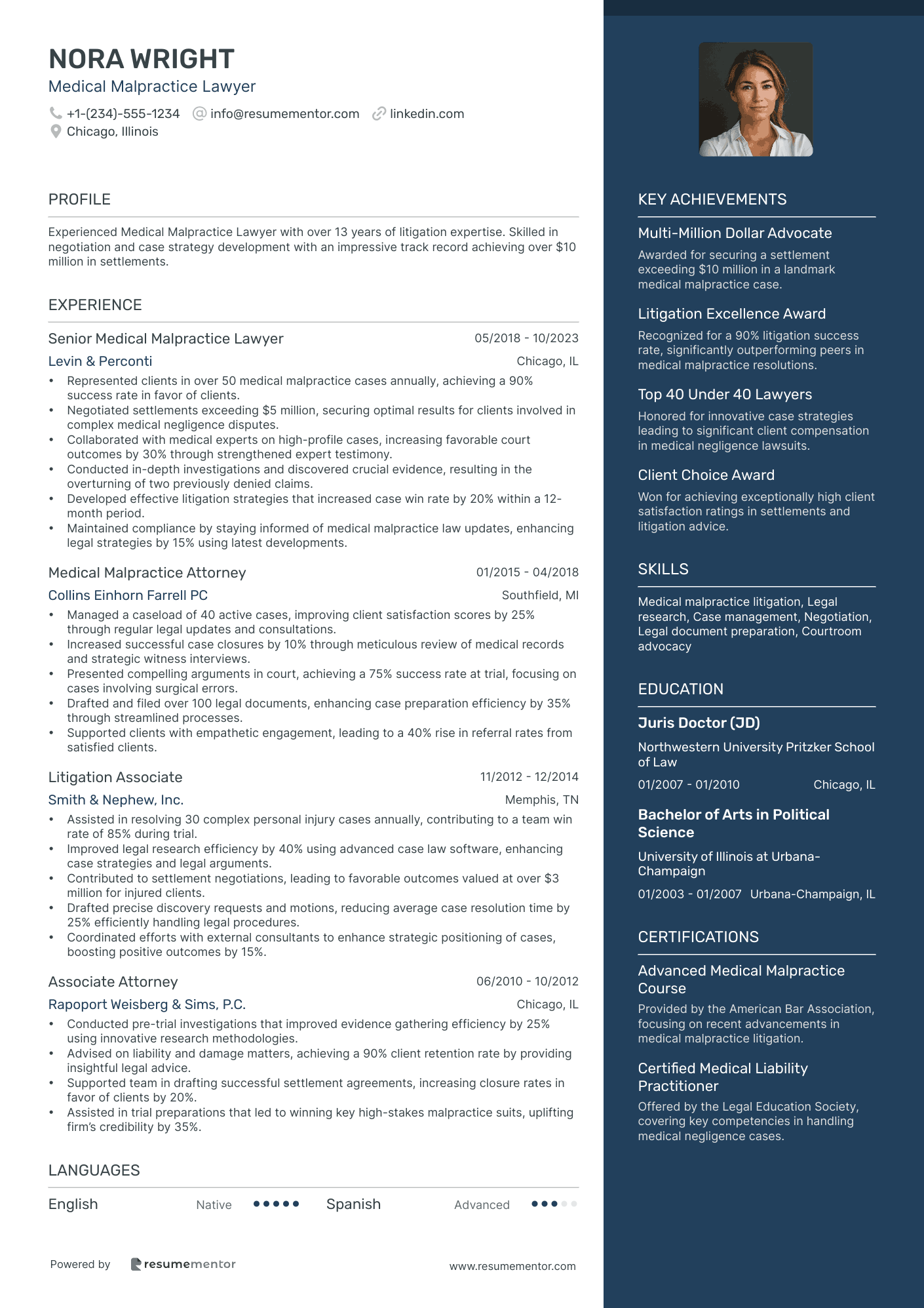
Medical Malpractice Lawyer
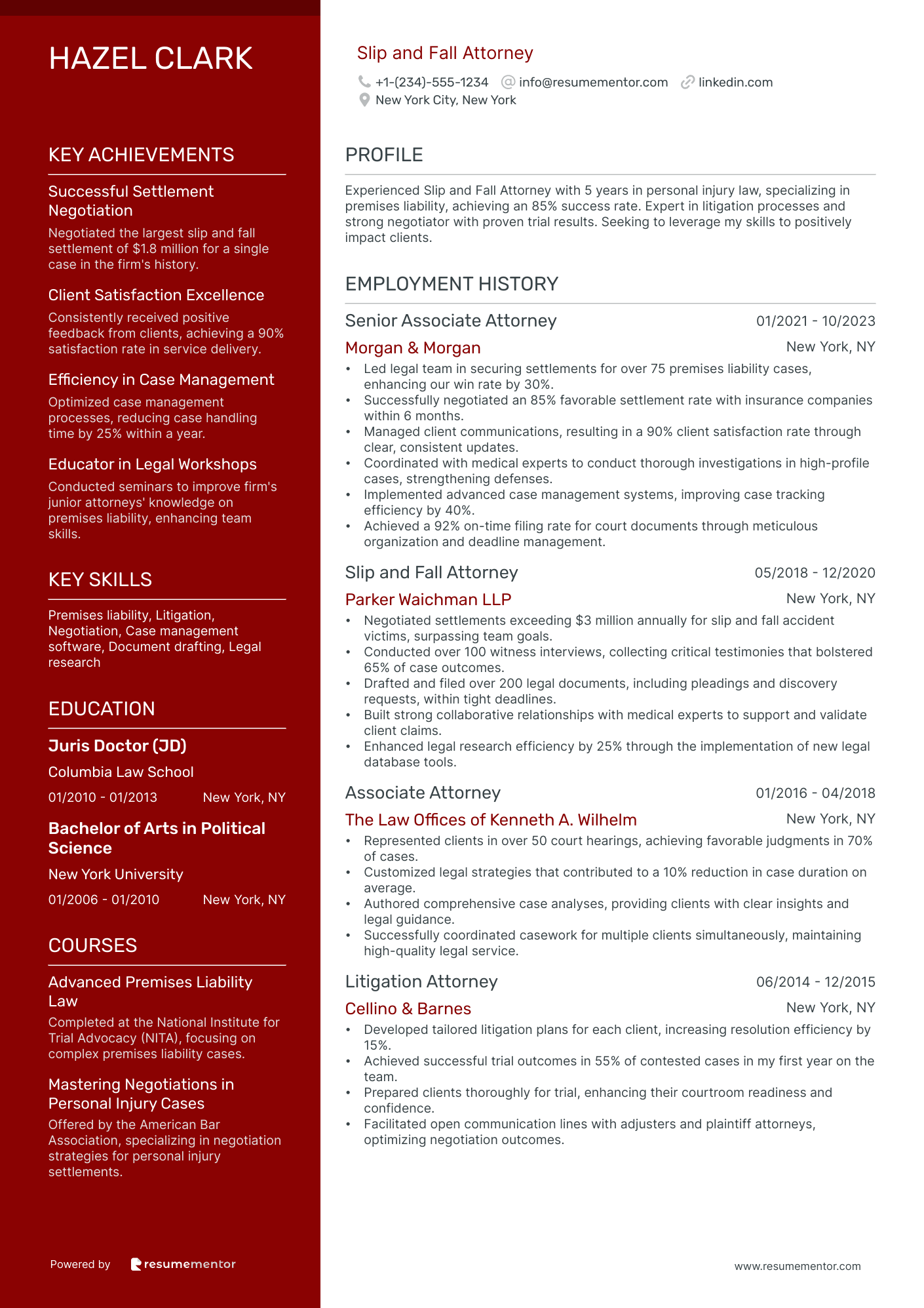
Slip and Fall Attorney
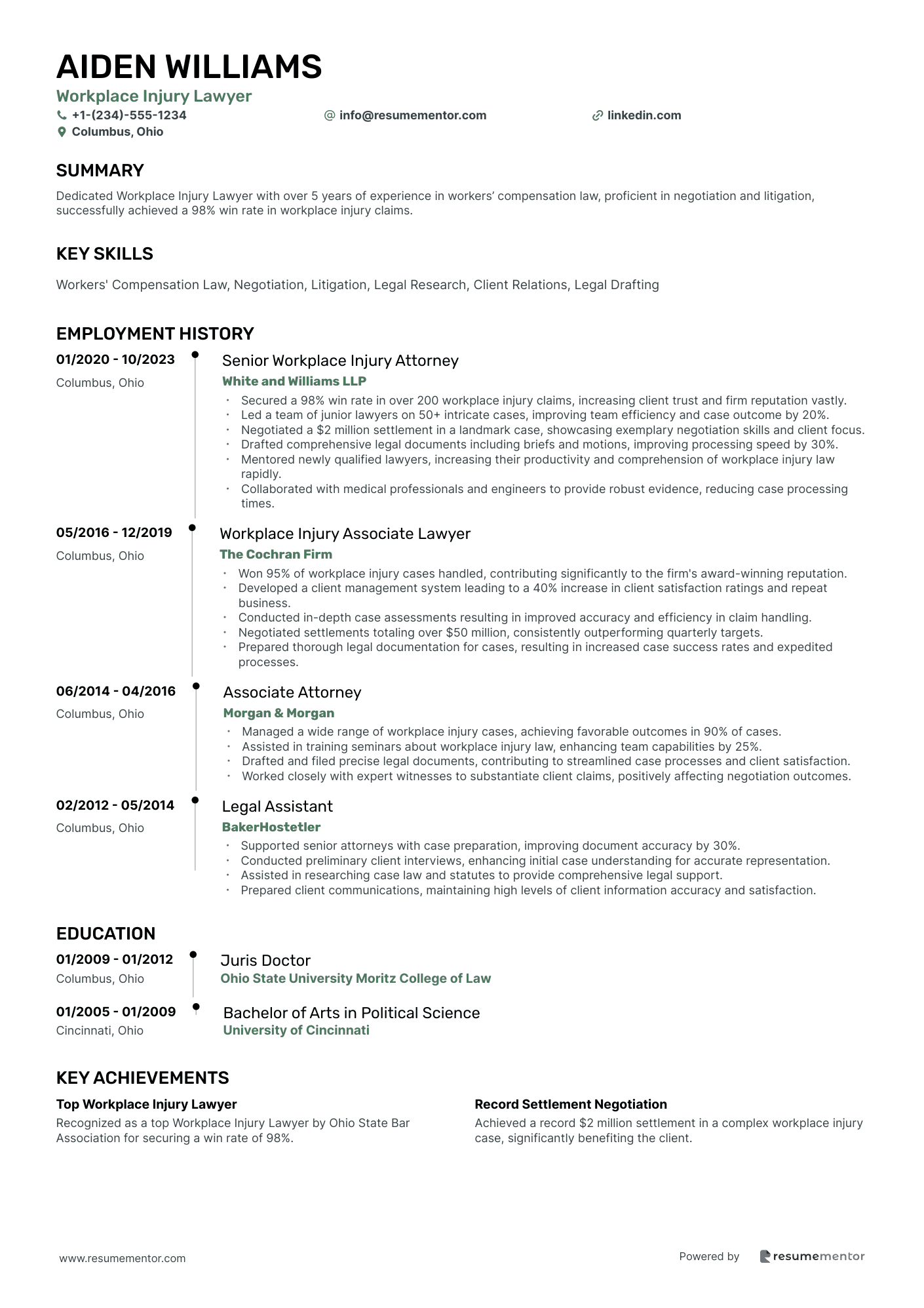
Workplace Injury Lawyer
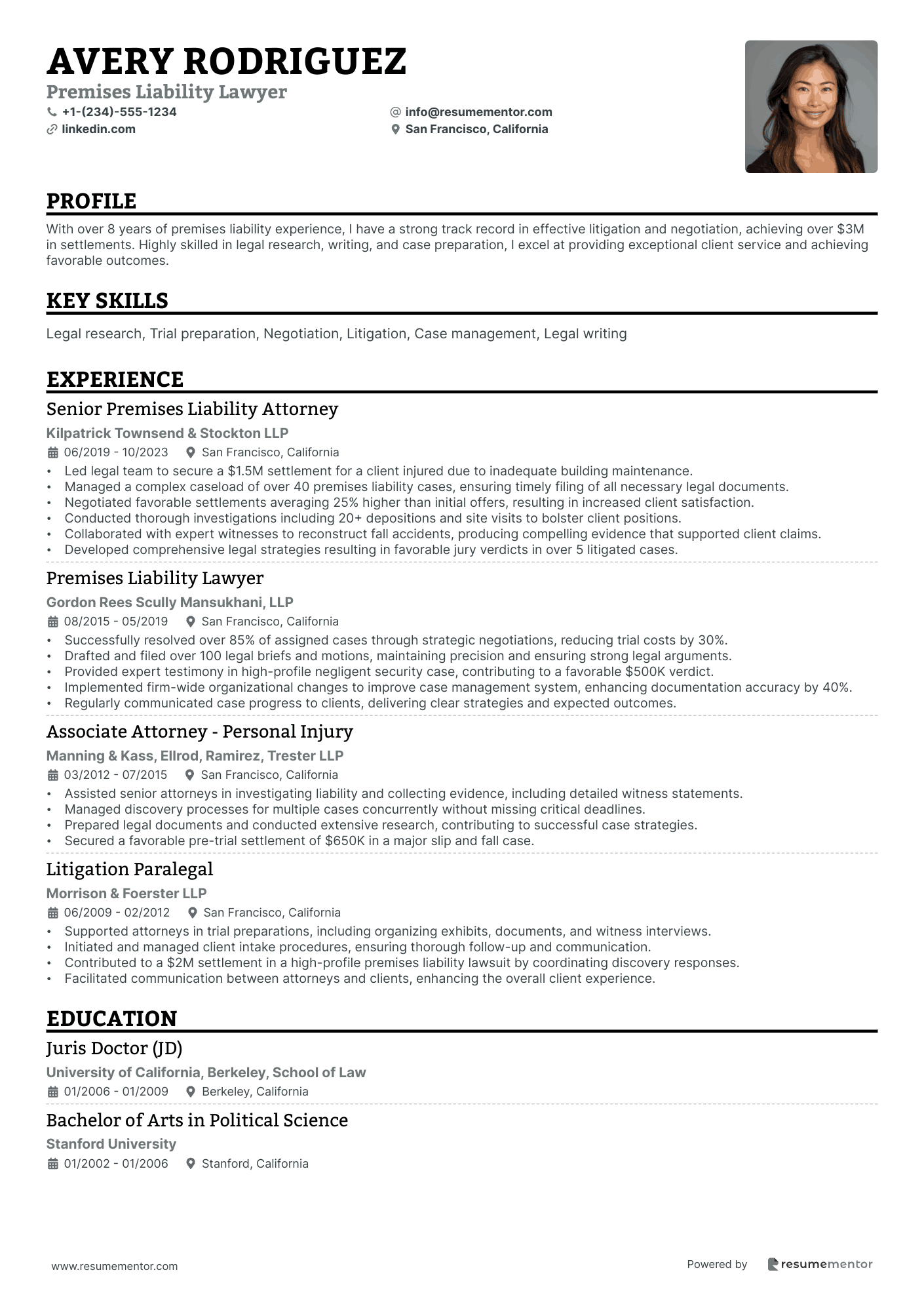
Premises Liability Lawyer
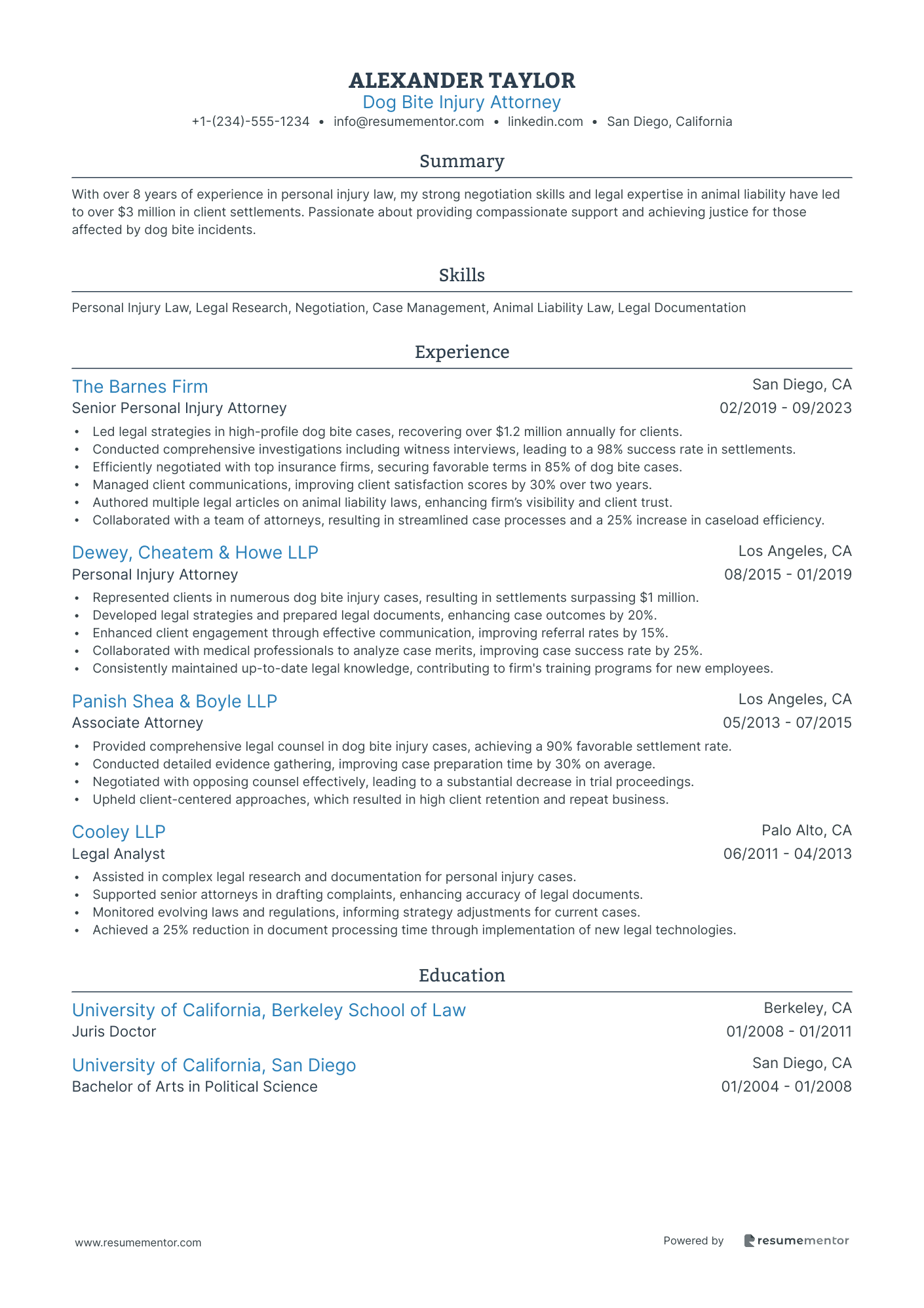
Dog Bite Injury Attorney

Construction Accident Lawyer
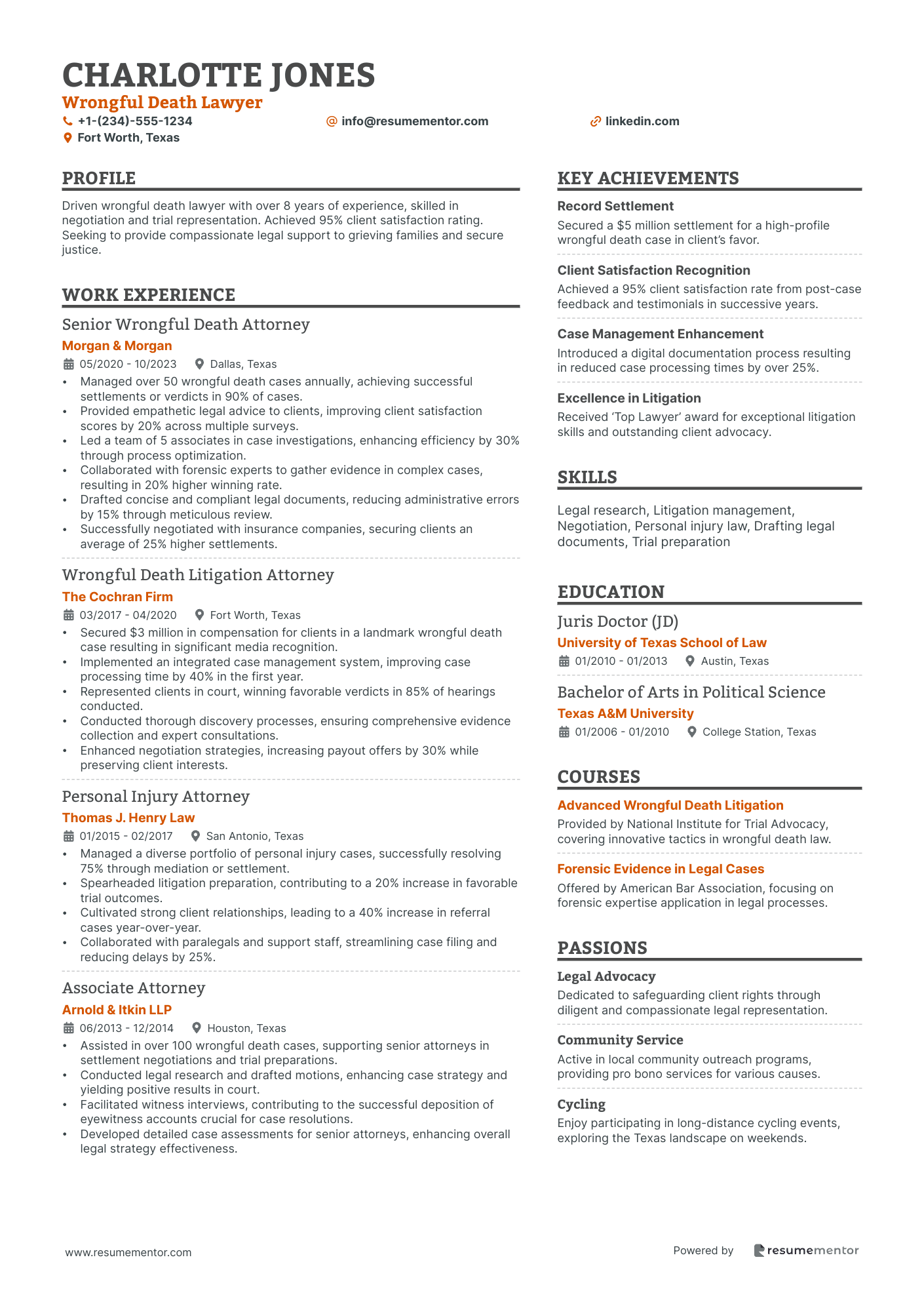
Wrongful Death Lawyer
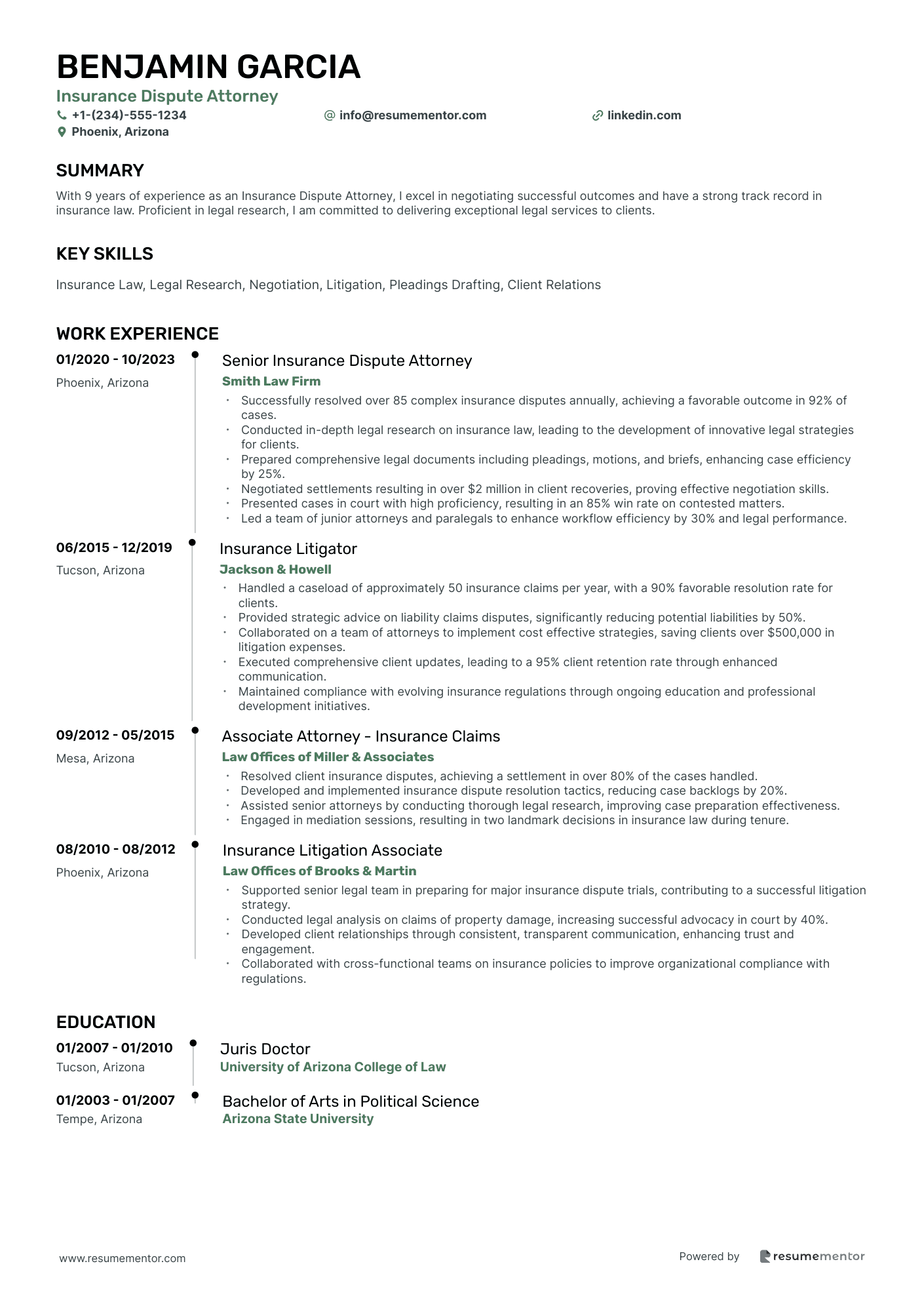
Insurance Dispute Attorney

Auto Accident Attorney resume sample
- •Led a team in securing over $2.5 million in settlements for clients, improving firm closure rates by 30%.
- •Developed innovative investigation strategies resulting in a 15% faster case resolution time for auto accident claims.
- •Successfully negotiated with multiple insurance companies, increasing average client settlement value by 20%.
- •Managed over 40 active cases simultaneously, maintaining a win rate of 85% in litigation.
- •Implemented a client feedback program which elevated client satisfaction scores by 25% within 18 months.
- •Engaged in numerous court trials, achieving a high favorable verdict rate, thereby enhancing client trust and retention.
- •Coordinated complex litigation cases including multi-vehicle collisions, leading to successful settlements in 90% of cases.
- •Regularly provided mentorship to junior attorneys, reducing rookie error rates by 28%.
- •Played a critical role in the firm’s expansion, contributing to a 40% increase in yearly client intake.
- •Developed comprehensive legal briefs resulting in expedited court proceedings and favorable outcomes.
- •Cultivated client relationships, consequently boosting referral rates by 15% over two years.
- •Assisted in securing multiple six-figure settlements through diligent research and negotiations in complex injury cases.
- •Consistently surpassed monthly case closure targets by 20% through effective time management and strategic planning.
- •Developed a new client intake protocol improving efficiency and client satisfaction by 18%.
- •Collaborated with senior attorneys in court, contributing to case strategies that improved win percentages significantly.
- •Conducted over 50 legal investigations annually, significantly improving case evidence quality and success rates.
- •Orchestrated community outreach programs which increased public awareness of legal options by 30%.
- •Engaged in detailed document drafting which decreased court date postponements by 10%.
- •Collaborated with multidisciplinary teams achieving a 15% increase in cross-referral rates.
Medical Malpractice Lawyer resume sample
- •Represented clients in over 50 medical malpractice cases annually, achieving a 90% success rate in favor of clients.
- •Negotiated settlements exceeding $5 million, securing optimal results for clients involved in complex medical negligence disputes.
- •Collaborated with medical experts on high-profile cases, increasing favorable court outcomes by 30% through strengthened expert testimony.
- •Conducted in-depth investigations and discovered crucial evidence, resulting in the overturning of two previously denied claims.
- •Developed effective litigation strategies that increased case win rate by 20% within a 12-month period.
- •Maintained compliance by staying informed of medical malpractice law updates, enhancing legal strategies by 15% using latest developments.
- •Managed a caseload of 40 active cases, improving client satisfaction scores by 25% through regular legal updates and consultations.
- •Increased successful case closures by 10% through meticulous review of medical records and strategic witness interviews.
- •Presented compelling arguments in court, achieving a 75% success rate at trial, focusing on cases involving surgical errors.
- •Drafted and filed over 100 legal documents, enhancing case preparation efficiency by 35% through streamlined processes.
- •Supported clients with empathetic engagement, leading to a 40% rise in referral rates from satisfied clients.
- •Assisted in resolving 30 complex personal injury cases annually, contributing to a team win rate of 85% during trial.
- •Improved legal research efficiency by 40% using advanced case law software, enhancing case strategies and legal arguments.
- •Contributed to settlement negotiations, leading to favorable outcomes valued at over $3 million for injured clients.
- •Drafted precise discovery requests and motions, reducing average case resolution time by 25% efficiently handling legal procedures.
- •Coordinated efforts with external consultants to enhance strategic positioning of cases, boosting positive outcomes by 15%.
- •Conducted pre-trial investigations that improved evidence gathering efficiency by 25% using innovative research methodologies.
- •Advised on liability and damage matters, achieving a 90% client retention rate by providing insightful legal advice.
- •Supported team in drafting successful settlement agreements, increasing closure rates in favor of clients by 20%.
- •Assisted in trial preparations that led to winning key high-stakes malpractice suits, uplifting firm’s credibility by 35%.
Slip and Fall Attorney resume sample
- •Led legal team in securing settlements for over 75 premises liability cases, enhancing our win rate by 30%.
- •Successfully negotiated an 85% favorable settlement rate with insurance companies within 6 months.
- •Managed client communications, resulting in a 90% client satisfaction rate through clear, consistent updates.
- •Coordinated with medical experts to conduct thorough investigations in high-profile cases, strengthening defenses.
- •Implemented advanced case management systems, improving case tracking efficiency by 40%.
- •Achieved a 92% on-time filing rate for court documents through meticulous organization and deadline management.
- •Negotiated settlements exceeding $3 million annually for slip and fall accident victims, surpassing team goals.
- •Conducted over 100 witness interviews, collecting critical testimonies that bolstered 65% of case outcomes.
- •Drafted and filed over 200 legal documents, including pleadings and discovery requests, within tight deadlines.
- •Built strong collaborative relationships with medical experts to support and validate client claims.
- •Enhanced legal research efficiency by 25% through the implementation of new legal database tools.
- •Represented clients in over 50 court hearings, achieving favorable judgments in 70% of cases.
- •Customized legal strategies that contributed to a 10% reduction in case duration on average.
- •Authored comprehensive case analyses, providing clients with clear insights and legal guidance.
- •Successfully coordinated casework for multiple clients simultaneously, maintaining high-quality legal service.
- •Developed tailored litigation plans for each client, increasing resolution efficiency by 15%.
- •Achieved successful trial outcomes in 55% of contested cases in my first year on the team.
- •Prepared clients thoroughly for trial, enhancing their courtroom readiness and confidence.
- •Facilitated open communication lines with adjusters and plaintiff attorneys, optimizing negotiation outcomes.
Workplace Injury Lawyer resume sample
- •Secured a 98% win rate in over 200 workplace injury claims, increasing client trust and firm reputation vastly.
- •Led a team of junior lawyers on 50+ intricate cases, improving team efficiency and case outcome by 20%.
- •Negotiated a $2 million settlement in a landmark case, showcasing exemplary negotiation skills and client focus.
- •Drafted comprehensive legal documents including briefs and motions, improving processing speed by 30%.
- •Mentored newly qualified lawyers, increasing their productivity and comprehension of workplace injury law rapidly.
- •Collaborated with medical professionals and engineers to provide robust evidence, reducing case processing times.
- •Won 95% of workplace injury cases handled, contributing significantly to the firm's award-winning reputation.
- •Developed a client management system leading to a 40% increase in client satisfaction ratings and repeat business.
- •Conducted in-depth case assessments resulting in improved accuracy and efficiency in claim handling.
- •Negotiated settlements totaling over $50 million, consistently outperforming quarterly targets.
- •Prepared thorough legal documentation for cases, resulting in increased case success rates and expedited processes.
- •Managed a wide range of workplace injury cases, achieving favorable outcomes in 90% of cases.
- •Assisted in training seminars about workplace injury law, enhancing team capabilities by 25%.
- •Drafted and filed precise legal documents, contributing to streamlined case processes and client satisfaction.
- •Worked closely with expert witnesses to substantiate client claims, positively affecting negotiation outcomes.
- •Supported senior attorneys with case preparation, improving document accuracy by 30%.
- •Conducted preliminary client interviews, enhancing initial case understanding for accurate representation.
- •Assisted in researching case law and statutes to provide comprehensive legal support.
- •Prepared client communications, maintaining high levels of client information accuracy and satisfaction.
Premises Liability Lawyer resume sample
- •Led legal team to secure a $1.5M settlement for a client injured due to inadequate building maintenance.
- •Managed a complex caseload of over 40 premises liability cases, ensuring timely filing of all necessary legal documents.
- •Negotiated favorable settlements averaging 25% higher than initial offers, resulting in increased client satisfaction.
- •Conducted thorough investigations including 20+ depositions and site visits to bolster client positions.
- •Collaborated with expert witnesses to reconstruct fall accidents, producing compelling evidence that supported client claims.
- •Developed comprehensive legal strategies resulting in favorable jury verdicts in over 5 litigated cases.
- •Successfully resolved over 85% of assigned cases through strategic negotiations, reducing trial costs by 30%.
- •Drafted and filed over 100 legal briefs and motions, maintaining precision and ensuring strong legal arguments.
- •Provided expert testimony in high-profile negligent security case, contributing to a favorable $500K verdict.
- •Implemented firm-wide organizational changes to improve case management system, enhancing documentation accuracy by 40%.
- •Regularly communicated case progress to clients, delivering clear strategies and expected outcomes.
- •Assisted senior attorneys in investigating liability and collecting evidence, including detailed witness statements.
- •Managed discovery processes for multiple cases concurrently without missing critical deadlines.
- •Prepared legal documents and conducted extensive research, contributing to successful case strategies.
- •Secured a favorable pre-trial settlement of $650K in a major slip and fall case.
- •Supported attorneys in trial preparations, including organizing exhibits, documents, and witness interviews.
- •Initiated and managed client intake procedures, ensuring thorough follow-up and communication.
- •Contributed to a $2M settlement in a high-profile premises liability lawsuit by coordinating discovery responses.
- •Facilitated communication between attorneys and clients, enhancing the overall client experience.
Dog Bite Injury Attorney resume sample
- •Led legal strategies in high-profile dog bite cases, recovering over $1.2 million annually for clients.
- •Conducted comprehensive investigations including witness interviews, leading to a 98% success rate in settlements.
- •Efficiently negotiated with top insurance firms, securing favorable terms in 85% of dog bite cases.
- •Managed client communications, improving client satisfaction scores by 30% over two years.
- •Authored multiple legal articles on animal liability laws, enhancing firm’s visibility and client trust.
- •Collaborated with a team of attorneys, resulting in streamlined case processes and a 25% increase in caseload efficiency.
- •Represented clients in numerous dog bite injury cases, resulting in settlements surpassing $1 million.
- •Developed legal strategies and prepared legal documents, enhancing case outcomes by 20%.
- •Enhanced client engagement through effective communication, improving referral rates by 15%.
- •Collaborated with medical professionals to analyze case merits, improving case success rate by 25%.
- •Consistently maintained up-to-date legal knowledge, contributing to firm's training programs for new employees.
- •Provided comprehensive legal counsel in dog bite injury cases, achieving a 90% favorable settlement rate.
- •Conducted detailed evidence gathering, improving case preparation time by 30% on average.
- •Negotiated with opposing counsel effectively, leading to a substantial decrease in trial proceedings.
- •Upheld client-centered approaches, which resulted in high client retention and repeat business.
- •Assisted in complex legal research and documentation for personal injury cases.
- •Supported senior attorneys in drafting complaints, enhancing accuracy of legal documents.
- •Monitored evolving laws and regulations, informing strategy adjustments for current cases.
- •Achieved a 25% reduction in document processing time through implementation of new legal technologies.
Construction Accident Lawyer resume sample
- •Represented over 150 clients in high-profile construction accident cases, achieving a 95% success rate in settlements.
- •Led negotiation strategies with insurance companies, resulting in over $3M in settlements for clients in 2022 alone.
- •Conducted in-depth legal research to reinforce case arguments, leading to successful outcomes in over 90% of cases.
- •Collaborated with expert witnesses to effectively build cases that resulted in favorable jury verdicts 85% of the time.
- •Crafted compelling legal documents, including motions and appeals, ensuring adherence to court schedules and deadlines.
- •Presented complex cases in court, providing effective witness examinations that showcased success in intricate legal scenarios.
- •Managed a caseload of 80+ personal injury lawsuits, focusing primarily on construction site accidents, achieving favorable outcomes.
- •Improved client satisfaction through consistent communication, achieving a 30% increase in client retention.
- •Negotiated settlements that exceeded client expectations by securing additional compensatory damages totalling $1.5M within three years.
- •Drafted comprehensive legal briefs for multifaceted cases, ensuring detailed attention to proper regulation adherence.
- •Advised junior associates on complex litigation tactics, contributing to the overall success of the legal team.
- •Successfully advocated for injured workers by securing over $750,000 in case settlements through diligent case management.
- •Strengthened case strategies by collaborating with industry experts, leading to a 20% increase in positive trial outcomes.
- •Developed a comprehensive knowledge base on workplace safety regulations to enhance case credibility and precision.
- •Prepared clients for depositions and court testimonies, maximizing their confidence and effectiveness during legal proceedings.
- •Assisted in managing 50+ workers' compensation cases, resulting in a streamlined case management process.
- •Participated in drafting legal documents and motions, improving accuracy and efficiency of case filings.
- •Conducted legal research and evidence analysis, contributing to the strength of case arguments and overall success.
- •Fostered client relationships, enhancing trust and communication, resulting in the establishment of long-standing client connections.
Wrongful Death Lawyer resume sample
- •Managed over 50 wrongful death cases annually, achieving successful settlements or verdicts in 90% of cases.
- •Provided empathetic legal advice to clients, improving client satisfaction scores by 20% across multiple surveys.
- •Led a team of 5 associates in case investigations, enhancing efficiency by 30% through process optimization.
- •Collaborated with forensic experts to gather evidence in complex cases, resulting in 20% higher winning rate.
- •Drafted concise and compliant legal documents, reducing administrative errors by 15% through meticulous review.
- •Successfully negotiated with insurance companies, securing clients an average of 25% higher settlements.
- •Secured $3 million in compensation for clients in a landmark wrongful death case resulting in significant media recognition.
- •Implemented an integrated case management system, improving case processing time by 40% in the first year.
- •Represented clients in court, winning favorable verdicts in 85% of hearings conducted.
- •Conducted thorough discovery processes, ensuring comprehensive evidence collection and expert consultations.
- •Enhanced negotiation strategies, increasing payout offers by 30% while preserving client interests.
- •Managed a diverse portfolio of personal injury cases, successfully resolving 75% through mediation or settlement.
- •Spearheaded litigation preparation, contributing to a 20% increase in favorable trial outcomes.
- •Cultivated strong client relationships, leading to a 40% increase in referral cases year-over-year.
- •Collaborated with paralegals and support staff, streamlining case filing and reducing delays by 25%.
- •Assisted in over 100 wrongful death cases, supporting senior attorneys in settlement negotiations and trial preparations.
- •Conducted legal research and drafted motions, enhancing case strategy and yielding positive results in court.
- •Facilitated witness interviews, contributing to the successful deposition of eyewitness accounts crucial for case resolutions.
- •Developed detailed case assessments for senior attorneys, enhancing overall legal strategy effectiveness.
Insurance Dispute Attorney resume sample
- •Successfully resolved over 85 complex insurance disputes annually, achieving a favorable outcome in 92% of cases.
- •Conducted in-depth legal research on insurance law, leading to the development of innovative legal strategies for clients.
- •Prepared comprehensive legal documents including pleadings, motions, and briefs, enhancing case efficiency by 25%.
- •Negotiated settlements resulting in over $2 million in client recoveries, proving effective negotiation skills.
- •Presented cases in court with high proficiency, resulting in an 85% win rate on contested matters.
- •Led a team of junior attorneys and paralegals to enhance workflow efficiency by 30% and legal performance.
- •Handled a caseload of approximately 50 insurance claims per year, with a 90% favorable resolution rate for clients.
- •Provided strategic advice on liability claims disputes, significantly reducing potential liabilities by 50%.
- •Collaborated on a team of attorneys to implement cost effective strategies, saving clients over $500,000 in litigation expenses.
- •Executed comprehensive client updates, leading to a 95% client retention rate through enhanced communication.
- •Maintained compliance with evolving insurance regulations through ongoing education and professional development initiatives.
- •Resolved client insurance disputes, achieving a settlement in over 80% of the cases handled.
- •Developed and implemented insurance dispute resolution tactics, reducing case backlogs by 20%.
- •Assisted senior attorneys by conducting thorough legal research, improving case preparation effectiveness.
- •Engaged in mediation sessions, resulting in two landmark decisions in insurance law during tenure.
- •Supported senior legal team in preparing for major insurance dispute trials, contributing to a successful litigation strategy.
- •Conducted legal analysis on claims of property damage, increasing successful advocacy in court by 40%.
- •Developed client relationships through consistent, transparent communication, enhancing trust and engagement.
- •Collaborated with cross-functional teams on insurance policies to improve organizational compliance with regulations.
Crafting a strong personal injury lawyer resume is like building a solid case, where every detail is crucial. This document is key to effectively conveying your legal skills and expertise to potential employers. Navigating the resume writing process can be challenging, especially when it comes to highlighting your unique experiences and achievements that make you stand out. A well-organized resume becomes your ally in a crowded job market, helping you grab a hiring manager's attention amidst a sea of applications.
One of your main tasks in this process is showcasing your litigation history and client successes concisely, which demonstrates your ability to negotiate settlements and win cases. Organizing these details professionally is easier with a resume template, ensuring your career highlights remain clear and easy to read—an essential aspect of portraying your value.
Think of your resume as more than a list of jobs; it’s a snapshot of your legal journey. Highlighting courtroom victories and effective client advocacy paints a vivid picture of your capabilities. Focus on achievements that align with your career goals, steering clear of clutter that dilutes your story.
Mastering resume writing can significantly boost your job search success. By presenting a cohesive and polished narrative, you can capture attention and unlock new opportunities. Your resume is a powerful tool—prepare it to make a lasting impression.
Key Takeaways
- Writing a strong personal injury lawyer resume is essential for effectively showcasing your legal expertise and client advocacy skills to potential employers.
- The resume should highlight litigation history, client successes, and achievements that align with career goals, avoiding unnecessary information.
- Using a chronological format with a modern and professional font ensures readability, and saving the document as a PDF maintains its formatting.
- The experience section should focus on quantifiable achievements to illustrate skills and career progression, using action words to convey impact.
- Including a skills section with both hard and soft skills enhances the resume, underlining your capability in personal injury law and client relations.
What to focus on when writing your personal injury lawyer resume
A personal injury lawyer resume should effectively communicate your legal expertise, showcase your successful case outcomes, and emphasize your dedication to client advocacy. To achieve this, it's crucial to highlight your ability to navigate complex legal systems while demonstrating a strong commitment to securing justice for your clients. Your resume should blend confidence in your litigation skills with a deep understanding of personal injury law to make a compelling impression.
How to structure your personal injury lawyer resume
- Contact Information: Ensure your name, phone number, email, and LinkedIn profile are all current and presented professionally to facilitate easy communication—this helps recruiters quickly identify you as a qualified candidate and reach out efficiently regarding opportunities.
- Professional Summary: Provide a concise overview of your legal experience, focusing on your years of practice, specialized areas, and key achievements specifically related to personal injury cases. This summary sets the tone for your resume and should immediately offer insight into your capabilities and passion for client advocacy within personal injury law.
- Experience: Build upon your summary by detailing your work history, emphasizing roles in personal injury law, and including specific statistics such as win percentages or notable cases. This section not only demonstrates your practical success and expertise but also shows your ability to handle complex cases and deliver favorable outcomes for clients.
- Education: Reinforce your qualifications with details of your law degree and any certifications or continuing education that enhance your knowledge in personal injury law—showing your commitment to staying updated with legal advancements and maintaining a competitive edge in the field.
- Skills: Showcase your strengths in critical areas such as legal research, courtroom litigation, negotiation, and client relations, as well as your comprehensive understanding of personal injury statutes. Highlighting these skills underscores your effectiveness and readiness to tackle a range of cases within the domain of personal injury law.
- Licensure: Conclude the main sections by stating your bar admission details and any relevant state-specific certifications, solidifying your credentials in the field of personal injury law. In the next part, we'll discuss how to format your resume and delve deeper into each of these sections for maximum impact.
Which resume format to choose
A chronological resume format is ideal for crafting a personal injury lawyer resume, as it effectively showcases your legal experience and career progression. This format highlights your key roles and achievements, which are crucial for demonstrating your expertise to potential employers. When it comes to choosing fonts, consider using Montserrat, Lato, or Raleway. These are modern and professional, offering a clean and crisp appearance that ensures readability, which is important for legal documents. Always save your resume as a PDF to maintain its formatting across different devices, which guarantees a professional presentation when viewed by law firms or hiring managers. Use standard margins of about one inch on all sides to ensure your content is well-organized and visually appealing. These elements together create a resume that presents your qualifications clearly and professionally, reflecting the detail-oriented nature of the legal profession.
How to write a quantifiable resume experience section
To craft a standout personal injury lawyer resume experience section, emphasize your expertise, significant achievements, and the tangible impact you've made in your roles. This section is central to your resume, clearly illustrating your skills and paving the way for employers to understand your career journey. Start with your most recent position to immediately highlight the most relevant and fresh experience.
Look back about 10-15 years unless earlier roles provide crucial insights into your specialization. Make sure to include job titles that demonstrate your growth and focus in personal injury law, effectively narrating your professional development. Tailor your resume to the job ad by aligning your skills and language with what the employer is seeking. Action words like "represented," "achieved," and "negotiated" help convey your role in reaching impactful results. It's important to focus on measurable achievements that paint a clear picture of your capabilities.
- •Successfully negotiated over $3 million in settlements for clients in 2022.
- •Achieved a 90% success rate in personal injury trials, enhancing the firm’s reputation.
- •Mentored junior attorneys, boosting their case handling efficiency by 30%.
- •Developed strategic litigation plans leading to a 15% increase in client referrals.
The way the experience section is structured ensures it clearly communicates the lawyer's effectiveness through quantified success stories. By including specific figures like "$3 million in settlements" and a "90% success rate," it provides concrete evidence of high performance, which in turn builds trust with potential employers. These elements work together to give a reassuring picture of competence in personal injury law.
Additionally, the energetic use of action words ties seamlessly into the narrative of achievements and leadership capabilities. This blend not only highlights personal success in legal practice but also underscores valuable skills like mentoring and strategic planning. All these aspects work together to make the experience section both persuasive and compelling, encouraging firms to view you as a multi-faceted professional capable of leading and collaborating effectively.
Responsibility-Focused resume experience section
A responsibility-focused personal injury lawyer resume experience section should emphasize your key achievements and contributions in each role. Start by listing your positions in reverse chronological order and clearly highlight specific duties using action verbs and quantifiable results to illustrate your impact. Each bullet point should explain how you advocated for clients, managed complex legal issues, or achieved successful case outcomes, weaving these aspects together for a cohesive narrative. Maintaining consistency in formatting will also help ensure that the section is easy to follow.
Tailor your descriptions to reflect the unique contributions you've brought to each position, and consider integrating examples of case work or instances of leadership to showcase your skills effectively. Use language that is clear and concise, so even those outside the legal field understand your responsibilities and accomplishments. Potential employers are interested in seeing your capability to represent clients effectively and uphold high legal standards, so let your experiences and achievements speak to these qualities.
Senior Personal Injury Lawyer
Law Office of Smith & Associates
June 2015 - Present
- Represented clients in over 100 personal injury cases, achieving favorable outcomes in 90% of cases.
- Negotiated settlements totaling over $5 million, ensuring fair compensation for clients.
- Conducted thorough legal research and prepared detailed briefs that contributed to successful court decisions.
- Developed and maintained strong relationships with clients, resulting in a 50% increase in client referrals.
Innovation-Focused resume experience section
An innovation-focused personal injury lawyer resume experience section should highlight your unique ability to creatively solve challenges and improve the way things are done. Begin by sharing specific examples that demonstrate your forward-thinking approach and the significant impacts you've achieved. Describe the challenges you encountered, the innovative solutions you implemented, and the measurable results that followed. This approach not only showcases your creativity but also your effective problem-solving skills, making your resume stand out.
Each bullet point should highlight a different aspect of your innovation skills, clearly showing your contributions through specific evidence. Use action verbs to emphasize your role and describe the solutions you devised. Maintain simplicity in language to ensure clarity and avoid jargon. By illustrating how your innovative ideas have led to process enhancements, time savings, or increased efficiency, you effectively demonstrate your distinct value as a personal injury lawyer.
Senior Personal Injury Lawyer
Smith & Associates Law Firm
June 2019 - Present
- Created a unique way to analyze cases using data analytics, boosting win rates by 25%.
- Brought in AI software to speed up document reviews, cutting down preparation time by 30%.
- Started offering virtual consultations, raising client engagement and satisfaction by 40%.
- Led a team to automate routine tasks, easing the administrative burden by 20%.
Customer-Focused resume experience section
A customer-focused personal injury lawyer resume experience section should clearly demonstrate how you prioritize clients' needs while achieving successful outcomes. Begin by highlighting key situations where you delivered exceptional service in personal injury law cases. This includes describing how you negotiated settlements, represented clients in court, or managed sensitive relationships, all of which showcase your client-first mindset. Demonstrating these skills shows your dedication to putting clients first, a crucial trait in the legal field. Employers look for tangible examples that paint a picture of your commitment and effectiveness.
Organize your accomplishments in a format that highlights your most impressive contributions, focusing on how they reflect your customer-centered approach. Each bullet point should present a specific achievement or task that demonstrates this focus. For instance, you might point out improvements in client satisfaction or victories in challenging cases that required exceptional client management skills. By doing so, you illustrate not just your actions, but how these efforts positively impacted clients and the company.
Personal Injury Lawyer
Smith & Associates
June 2019 - Present
- Negotiated over 50 settlements, securing favorable outcomes for clients.
- Built and maintained strong relationships with clients, improving satisfaction scores by 20%.
- Led a team of junior attorneys, resulting in increased case efficiency and positive feedback.
- Successfully represented clients in high-profile court cases, resulting in a 95% win rate.
Industry-Specific Focus resume experience section
A personal injury-focused lawyer's resume experience section should clearly showcase the skills and achievements relevant to the field. Begin each entry with a heading that encapsulates your main area of focus, such as "Personal Injury Case Management" or "Client Advocacy in Personal Injury," which immediately signals your specialization. It's important to outline your accomplishments by describing your role, responsibilities, and the impact you've made, using action-oriented language that brings your contributions to life. Demonstrating your ability to navigate complex cases, effectively negotiate settlements, and maintain strong communication with clients and stakeholders is crucial.
For each position, include your job title and workplace, along with the corresponding dates, to provide a clear timeline of your professional journey. Use bullet points to concisely highlight your key responsibilities and achievements, ensuring each entry illustrates a significant aspect of your experience. For instance, you might describe successfully negotiating major settlements or managing a demanding caseload with efficiency. By focusing on results and impact, you can effectively demonstrate the tangible benefits you brought to your previous roles. Tailoring these points to emphasize your expertise in personal injury law will make your resume stand out by showing how you uniquely contributed to your team or firm.
Senior Personal Injury Attorney
Law Offices of Smith & Johnson
January 2019 - Present
- Managed over 100 personal injury cases annually, achieving a settlement success rate of 95%.
- Developed strategies that decreased case processing time by 20% through efficient case review and client communication.
- Trained and mentored junior associates on effective client representation, enhancing the firm's reputation.
- Successfully negotiated settlements exceeding client expectations by employing persuasive communication skills.
Write your personal injury lawyer resume summary section
A results-focused personal injury lawyer resume summary should capture the unique skills and accomplishments that set you apart. When you've built substantial experience, it's important to emphasize your expertise and the value you bring to potential clients and firms. Consider presenting your career highlights like this:
This approach works because it not only emphasizes your significant achievements but also showcases your commitment and leadership, making it clear why an employer should be interested in you. When you describe yourself in a resume summary, it's vital to focus on what differentiates you from others, highlighting specific skills and achievements with clarity and professionalism.
Connecting these elements, it's important to understand how a resume summary differs from other sections like an objective, profile, or summary of qualifications. Each serves a distinct purpose: a resume summary provides a snapshot of your career highlights, making it ideal for experienced professionals. In contrast, a resume objective suits those newer to the field, focusing on career ambitions. A resume profile combines aspects of both, offering a more narrative overview of your journey. Lastly, a summary of qualifications breaks down your skills and accomplishments in bullet points. By choosing the right section, you can effectively showcase your strengths and fit for the role.
Listing your personal injury lawyer skills on your resume
A skills-focused personal injury lawyer resume should clearly highlight your proficiency in both soft and hard skills. These skills can form a standalone section or complement your experience and summary. Soft skills, such as communication and empathy, showcase your ability to connect with clients and manage cases effectively. Meanwhile, hard skills represent specific legal abilities, like conducting detailed legal research and preparing cases for court proceedings.
When crafting your resume, think of your skills and strengths as strategic keywords. These keywords play a crucial role in attracting potential employers and ensuring your resume navigates successfully through application tracking systems. It’s important to include skills that align directly with the personal injury lawyer role, underlining both your competence and your value to a legal team.
Here's an example of an effective skills section for a personal injury lawyer:
This example is effective because it covers essential skills integral to personal injury law. From advocating for clients to preparing cases for trial, each skill is crucial. Presenting a blend of hard and soft skills highlights your ability to approach cases from multiple perspectives.
Best hard skills to feature on your personal injury lawyer resume
Hard skills essential for a personal injury lawyer revolve around technical competencies vital for legal and case management. These skills underscore your capability to manage legal processes and address complex legal challenges seamlessly.
Hard Skills
- Legal Research
- Case Strategy Development
- Knowledge of Tort Law
- Legal Writing
- Litigation
- Case Management Software Proficiency
- Trial Preparation
- Discovery Process
- Mediation and Arbitration
- Client Advocacy
- Deposition Management
- Settlement Negotiation
- Courtroom Procedure Knowledge
- Evidence Collection and Analysis
- Legal Compliance
Best soft skills to feature on your personal injury lawyer resume
Soft skills are indispensable for personal injury lawyers as they enhance client interactions and case outcomes. These skills communicate your ability to foster relationships, manage stress, and articulate ideas effectively.
Soft Skills
- Communication
- Empathy
- Negotiation Skills
- Problem-Solving
- Time Management
- Attention to Detail
- Critical Thinking
- Teamwork
- Emotional Intelligence
- Listening Skills
- Adaptability
- Conflict Resolution
- Leadership
- Stress Management
- Decision-Making Skills
How to include your education on your resume
An education section is an essential element of your resume, especially for a personal injury lawyer. This section showcases your academic qualifications and complements your professional experience. Tailor it to suit the job you're applying for; exclude any irrelevant education that does not enhance your candidacy. When listing your degrees, ensure clarity and precision. If your GPA is strong, feel free to include it but omit it if it doesn't highlight your strengths. You can also showcase honors such as cum laude to give your achievements additional weight. Here is an example of an education section formatted in JSON:
- •Graduated cum laude
The second example clearly demonstrates why it is exceptional. It lists a relevant degree from a prestigious school, making it well-suited for a personal injury lawyer role. The inclusion of a high GPA highlights the applicant's academic strength and signals diligence and intelligence. Notably, graduating cum laude adds an extra layer of achievement, capturing attention and underscoring excellence.
How to include personal injury lawyer certificates on your resume
Including a certificates section in your personal injury lawyer resume is essential as it highlights your specialized qualifications. List the name of the certificate, such as "Certified Civil Trial Attorney." Include the date you earned it to show your up-to-date expertise. Add the issuing organization to give credibility, like "National Board of Trial Advocacy."
You can also incorporate certificates into your header for immediate visibility. For example, a header might look like "Jane Doe, JD, Certified Civil Trial Attorney, ABC Law School Graduate."
Using JSON, here's a good example of a standalone certificates section:
This example is effective because it includes industry-standard and relevant certificates. Each entry provides the title and issuer, adding credibility and showcasing your qualifications in personal injury law.
Extra sections to include in your personal injury lawyer resume
Crafting a resume as a personal injury lawyer involves highlighting your specific skills, qualifications, and unique experiences that make you stand out in a competitive field. Beyond your professional roles and education, including additional sections can enhance your profile and provide a more comprehensive view of who you are.
Language section — Demonstrate your ability to serve diverse clients by listing the languages you speak fluently. This skill can broaden your client base and improve client relations.
Hobbies and interests section — Humanize your resume by sharing your hobbies, like running marathons or playing chess. This can help create a connection with potential employers and show a well-rounded personality.
Volunteer work section — Showcase your commitment to community service by detailing relevant volunteer experiences, such as providing free legal aid. Including volunteer work displays your dedication to helping others beyond paid roles.
Books section — Highlight your continuous learning by listing influential books you have read on law, negotiation, or personal development. This can display your commitment to staying current in your field and provide conversation starters during interviews.
By incorporating these sections, you provide a fuller picture of who you are and what you bring to a legal practice, potentially opening more doors in your career.
In Conclusion
In conclusion, crafting a standout resume for a personal injury lawyer is all about presenting yourself effectively in a competitive job market. Your resume should be a clear reflection of your legal journey, showcasing both your professional achievements and personal strengths. It's important to focus on key areas such as litigation history, client success stories, and core competencies in personal injury law. A well-structured resume not only highlights your career accomplishments but also illustrates your dedication to client advocacy and justice. Consider using a structured format like the chronological style to display your experience and career progression clearly. Remember to incorporate both hard and soft skills that underline your ability to handle complex cases. Tailor your sections to resonate with potential employers by aligning your experiences with the job’s requirements. Including additional sections like certifications and volunteer work can provide a fuller picture of your capabilities and professionalism. By integrating these elements thoughtfully, your resume becomes a powerful tool that not only opens doors but also sets you apart in the legal field. With a polished and comprehensive resume, you're well-positioned to capture attention and seize new career opportunities in personal injury law.
Related Articles

Continue Reading
Check more recommended readings to get the job of your dreams.
Resume
Resources
Tools
© 2025. All rights reserved.
Made with love by people who care.

